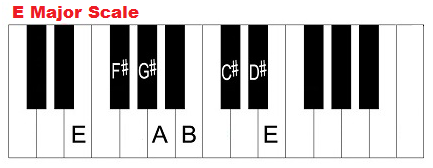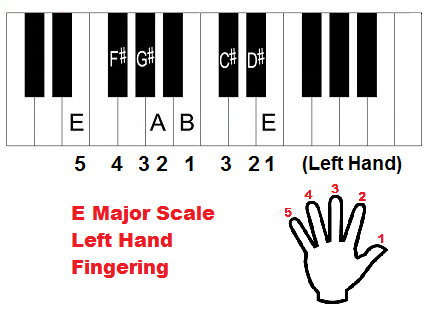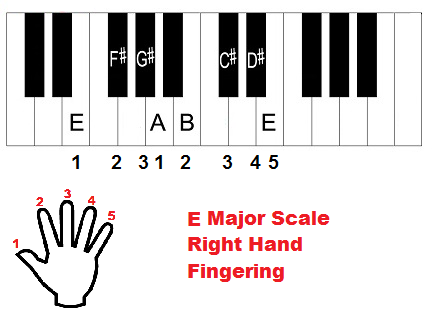In this lesson we will learn how to play the E major scale. We will take a look at the notes of this scale, its intervals, degrees, modes, relative minor, diatonic triads, fingering and more. We will take a look at diagrams of this scale on the piano keyboard, treble and bass clef.
The notes of the the scale are E, F♯, G♯, A, B, C♯, and D♯. The note, E repeats one octave higher. Its key signature has four sharps.
To learn more about this scale and others, check out my course, Learn Scales & Music Theory & Give Yourself An Upper Hand.
Intervals
- Tonic: E
- Major 2nd: F#
- Major 3rd: G#
- Perfect 4th: A
- Perfect 5th: B
- Major 6th: C#
- Major 7th: D#
- Perfect 8th: E
Piano diagram showing the notes of the E major scale:
Scale Degrees
- Tonic: E
- Supertonic: F#
- Mediant: G#
- Subdominant: A
- Dominant: B
- Submediant: C#
- Leading tone: D#
- Octave: E
Treble clef:
Bass clef:
Video:
Major Scale Formula
Major scales are constructed with the formula W – W – H – W – W – W – H. “W” represents a whole step, while “H” represents a half step.
Using this formula, let’s figure out the E major scale. First start with the root note, A, and follow the formula:
- A whole step from E is F#.
- A whole step from F# is G#.
- A half step from G# is A.
- A whole step from A is B.
- A whole step from B is C#.
- A whole step from C# is D#.
- A half step from D# is E, back to the top.
The above ‘major scale formula’ is all you need to write a major scale in any key.
How to Play E Major Scale on Piano (Fingering)
What’s the fingering for this scale? It’s as follows:
- Notes: E, F#, G#, A, B, C#, D#, E
- Fingerings (Left Hand): 5, 4, 3, 2, 1, 3, 2, 1
- Fingerings (Right Hand ): 1, 2, 3, 1, 2, 3, 4, 5
(Thumb is finger 1, index finger is finger 2, middle finger is 3, ring finger is 4 and pinky finger is 5.)
Video – How to Play E Major Scale on Piano:


Chords in the Key of E Major – Based on E Major Scale
What are the triad chords in the key of E? They are as follows:
- Chord I: E major. Its notes are E – G# – B.
- Chord ii: F# minor. Its notes are F# – A – C#.
- Chord iii: G# minor. Its notes are G# – B – D#.
- Chord IV: A major. Its notes are A – C# – E.
- Chord V: B major. It’s notes are B – D# – F#.
- Chord vi: C# minor. Its notes are C# – E – G#.
- Chord vii: D# diminished. Its notes are D# – F# – A.
Diatonic Triads In key of E major: E – F#m – G#m – A – B – C#m – D#dim
What are the chords in the key of E major? Triads, sevenths, notes, scale and key signature.
Here’s a video showing you the chords in the key of E major on piano.
The relative minor of E major is C# minor. The relative minor of a major key is based on the 6th note of the major scale. Major scales and their relative minors share the same notes. The notes of the B minor scale are: C♯ – D♯ – E – F♯ – G♯ – A – B – C♯.
Modes:
- Ionian/Major Scale: E – F♯ – G♯ – A – B – C♯ – D♯ – E
- Dorian: F♯ – G♯ – A – B – C♯ – D♯ – E – F♯
- Phrygian: G♯ – A – B – C♯ – D♯ – E – F♯ – G♯
- Lydian: A – B – C♯ – D♯ – E – F♯ – G♯ – A
- Mixolydian: B – C♯ – D♯ – E – F♯ – G♯ – A – B
- Aeolian/Natural minor scale: C♯ – D♯ – E – F♯ – G♯ – A – B – C♯
- Locrian: D♯ – E – F♯ – G♯ – A – B – C♯ – D♯
Learn how to build piano scales here. How to form major, minor, chromatic scales, etc. on piano.